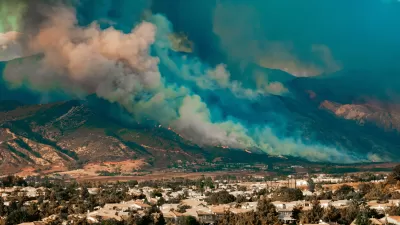The connection between housing policy and climate change is made clear by the increasing damage of wildfires in California.

An article by Amanda Brown-Stevens, Brian Hanlon, and Sarah Karlinsky lays out the unprecedented crisis of climate and housing in California and also offers a few policy recommendations to combat wildfire risk and save lives, homes, and communities.
"The seven largest wildfires in recorded California history have all taken place in the last four years," they write. "At the same time, the state is experiencing a massive housing shortage, which is driving up the cost of housing and forcing people to move farther away from job centers in search of more affordable housing."
The article reflects a series of principles developed in partnership between SPUR, Greenbelt Alliance, and California YIMBY. The three principles read as follows, with more detail included in the source article.
- Support higher density growth in in-fill locations that aren’t impacted by wildfire risk
- Differentiate between different levels of wildfire risk and develop regional planning tools for determining fire risk to inform growth plans
- Don’t build new housing or job centers in areas of the highest wildfire risk as defined by regional planning processes such as the Sustainable Communities Strategy
- Develop guidance to inform how existing towns and cities with higher fire risk should approach growth and mitigation
- Harden existing structures and create defensible space requirements
- Align utility planning and insurance regulation policies with wildfire risk and growth plans.
FULL STORY: Managing Wildfire Risk and New Development

Alabama: Trump Terminates Settlements for Black Communities Harmed By Raw Sewage
Trump deemed the landmark civil rights agreement “illegal DEI and environmental justice policy.”

Study: Maui’s Plan to Convert Vacation Rentals to Long-Term Housing Could Cause Nearly $1 Billion Economic Loss
The plan would reduce visitor accommodation by 25% resulting in 1,900 jobs lost.

Planetizen Federal Action Tracker
A weekly monitor of how Trump’s orders and actions are impacting planners and planning in America.

Waymo Gets Permission to Map SF’s Market Street
If allowed to operate on the traffic-restricted street, Waymo’s autonomous taxis would have a leg up over ride-hailing competitors — and counter the city’s efforts to grow bike and pedestrian on the thoroughfare.

Parklet Symposium Highlights the Success of Shared Spaces
Parklets got a boost during the Covid-19 pandemic, when the concept was translated to outdoor dining programs that offered restaurants a lifeline during the shutdown.

Federal Homelessness Agency Places Entire Staff on Leave
The U.S. Interagency Council on Homelessness is the only federal agency dedicated to preventing and ending homelessness.
Urban Design for Planners 1: Software Tools
This six-course series explores essential urban design concepts using open source software and equips planners with the tools they need to participate fully in the urban design process.
Planning for Universal Design
Learn the tools for implementing Universal Design in planning regulations.
Caltrans
Smith Gee Studio
Institute for Housing and Urban Development Studies (IHS)
City of Grandview
Harvard GSD Executive Education
Toledo-Lucas County Plan Commissions
Salt Lake City
NYU Wagner Graduate School of Public Service





























